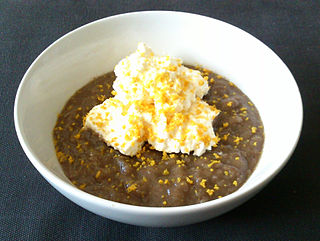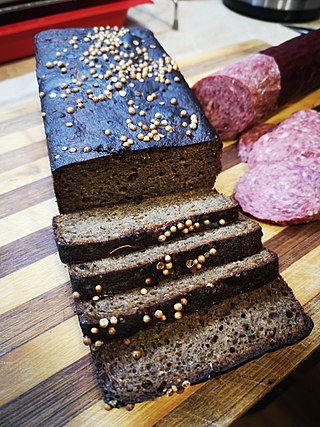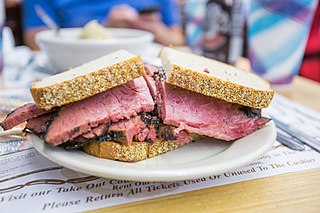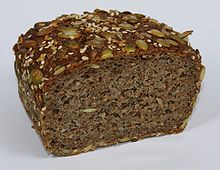
A cereal is any grass cultivated for its edible grain, which is composed of an endosperm, a germ, and a bran. Cereal grain crops are grown in greater quantities and provide more food energy worldwide than any other type of crop and are therefore staple crops. They include rice, wheat, rye, oats, barley, millet, and maize. Edible grains from other plant families, such as buckwheat, quinoa, and chia, are referred to as pseudocereals.

The cuisine of Germany consists of many different local or regional cuisines, reflecting the country's federal history. Germany itself is part of the larger cultural region of Central Europe, sharing many culinary traditions with neighbouring countries such as Poland and the Czech Republic. In Northern Europe, in Denmark more specifically, the traditional Danish cuisine had also been influenced by German cuisine in the past, hence several dishes being common between the two countries.

Bread is a staple food prepared from a dough of flour and water, usually by baking. Throughout recorded history and around the world, it has been an important part of many cultures' diet. It is one of the oldest human-made foods, having been of significance since the dawn of agriculture, and plays an essential role in both religious rituals and secular culture.

Rye is a grass grown extensively as a grain, a cover crop and a forage crop. It is a member of the wheat tribe (Triticeae) and is closely related to both wheat and barley. Rye grain is used for flour, bread, beer, crispbread, some whiskeys, some vodkas, and animal fodder. It can also be eaten whole, either as boiled rye berries or by being rolled, similar to rolled oats.

Flour is a powder made by grinding raw grains, roots, beans, nuts, or seeds. Flours are used to make many different foods. Cereal flour, particularly wheat flour, is the main ingredient of bread, which is a staple food for many cultures. Corn flour has been important in Mesoamerican cuisine since ancient times and remains a staple in the Americas. Rye flour is a constituent of bread in both Central Europe and Northern Europe.

Rugbrød is a very common form of rye bread from Denmark. Rugbrød usually resembles a long brown extruded rectangle, no more than 12 cm high, and 30–35 cm wide, depending on the bread pan in which it is baked. The basic ingredient is rye flour which will produce a plain or "old-fashioned" bread of uniform, somewhat heavy structure, but the most popular versions today contain whole grains and often other seeds such as sunflower seeds, linseeds or pumpkin seeds. Most Danes eat rugbrød every day.

Peasant foods are dishes eaten by peasants, made from accessible and inexpensive ingredients.
Latvian cuisine typically consists of agricultural products, with meat featuring in most main meal dishes. Fish is commonly consumed due to Latvia's location on the eastern shore of the Baltic Sea.

Rye bread is a type of bread made with various proportions of flour from rye grain. It can be light or dark in color, depending on the type of flour used and the addition of coloring agents, and is typically denser than bread made from wheat flour. Compared to white bread, it is higher in fiber, darker in color, and stronger in flavor. The world's largest exporter of rye bread is Poland.

Brown bread is bread made with significant amounts of whole grain flour, usually wheat, and sometimes dark-coloured ingredients such as molasses or coffee. In Canada, Ireland and South Africa, it is whole wheat bread; in the Maritimes and New England, it is bread made with molasses. In some regions of the US, brown bread is called wheat bread to complement white bread.

Sprouted bread is a type of bread made from whole grains that have been allowed to sprout, that is, to germinate, before being milled into flour. There are a few different types of sprouted grain bread. Some are made with additional added flour, some are made with added gluten, and some, such as Essene bread and Ezekiel bread, are made with very few additional ingredients.

Øllebrød is a traditional Danish dish. It is a porridge or thick soup made of sourdough rye bread (rugbrød) and beer. These ingredients give it a slightly sour-sweet, caramelly, full taste. It is often eaten for breakfast, a par with oatmeal porridge. It is also regarded as easily digestible and nourishing and frequently served in hospitals and retirement homes.

Borodinsky bread or borodino bread is a dark brown sourdough rye bread of Russian origin, traditionally sweetened with molasses and flavored with coriander and caraway seeds.

Sandwich bread is bread that is prepared specifically to be used for the preparation of sandwiches. Sandwich breads are produced in many varieties, such as white, whole wheat, sourdough, rye, multigrain and others.

Bread is a staple food throughout Europe. Throughout the 20th century, there was a huge increase in global production, mainly due to a rise in available, developed land throughout Europe, North America and Africa.

A baking mix is a mixed formulation of ingredients used for the cooking of baked goods. Baking mixes may be commercially manufactured or homemade. Baking mixes that cater to particular dietary needs, such as vegan, gluten-free, or kosher baking mixes, can be bought in many places.

Bulgur, or burghul, is a cracked wheat foodstuff found in West Asian cuisine.

Jewish rye bread is a type of rye bread commonly made in Jewish communities. Due to the diaspora of the Jews, there are several geographical variations of the bread. The bread is sometimes called sissel bread or cissel bread, as sissel means caraway seed in Yiddish.

Vörtbröd is a sweet Scandinavian rye bread, associated with Swedish cuisine. It is a yeast-leavened spice loaf, sweetened with brown sugar and molasses which comes in a large variety in regards to whether or not butter-enriched, and which spices are being used. Traditional bread spices are anise, caraway, fennel seeds, and bitter orange.




















